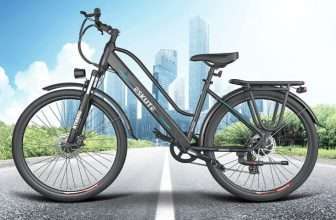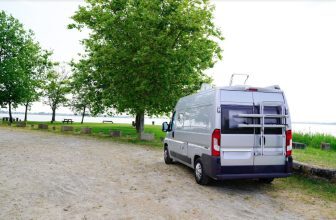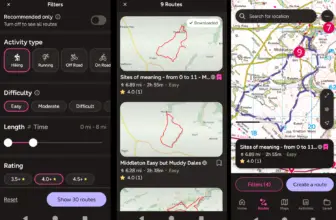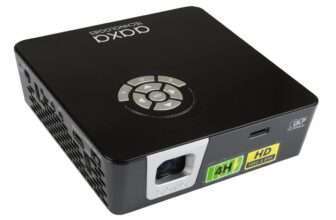If you want the longevity and safety of Li-Po batteries to be coupled with a very meaty 2.2kW inverter then the Bluetti AC200 Max could be for you. We give it a whirl….
What we like about the Bluetti AC200Max: The best 2kW+ inverter we’ve tested; 4 x AC sockets; Colour Touchscreen; Expandable battery capacity; Great battery lifetime; No bespoke cables required.
What we don’t like about the Bluetti AC200Max: Heavy pack; External power brick with slow mains charging; Some efficiency concerns (actual storage vs stated storage).
One of the problems with lithium battery power stations as standalone products is that they’re not generators per se. They can only store electricity up to their stated capacity, but cannot create it on their own unless it is pumped into them form another source.
In practice, what this means is that if you’re using a 1000Wh power pack with say a 50W fridge, and no available mains or solar power then you can only run the fridge for a maximum of 16-18 hours or so. This is not much use if you’re camping for a full weekend. The battery would be drained before the end of the first day!
One way around this problem is to use a larger capacity power station like the Bluetti AC200Max which we review in this article. It is Bluetti’s flagship power pack and has a very decent 2048Wh of nameplate capacity – it could therefore run that theoretical fridge for twice as long at 36 hours – perfect for a weekend.
We’ve spent several weeks with the AC200Max, charging it and discharging it repeatedly to test its performance with a range of household and camping appliances. Read on to find out how it performed….
Contents
ToggleBluetti AC200Max – What’s in the box?
 The courier delivered the AC200Max to Camping Secrets Towers, and I was immediately struck by the size and weight of the power pack. It took alot of effort to shift the cardboard box from the porch into the house, mainly because there was no handles fitted. Some people might need a trolley to shift this before it is unpacked.
The courier delivered the AC200Max to Camping Secrets Towers, and I was immediately struck by the size and weight of the power pack. It took alot of effort to shift the cardboard box from the porch into the house, mainly because there was no handles fitted. Some people might need a trolley to shift this before it is unpacked.
So what do you get in the box?
- Bluetti AC200Max – you get the power station itself of course.
- 400W mains power supply and cable – this is an external power brick with its own fan which can be used to chargeup the AC200Max from mains 220-240V.
- Aviation to XT-90 connector cable – the aviation connector is used to get external DC 12V or solar power into the AC200Max, and the XT-90 connector on the other end can either connect direct to your solar panels, or to the other conversion cables in the box.
- XT-90 to MC4 cable conversion cable – this is used to connect the AC200Max to solar panels which use standard MC4 connectors.
- XT-90 to cigarette lighter conversion cable – this is used to charge the AC200Max from a car 12V cigarette socket
- User manual and warranty certification
AC200Max Battery Technology and Inverter – Key Components
Bluetti are firm believers in LiFePO4 (LFP) battery technology, and have incorporated LFP cells in all their power stations. The reasons for this are numerous, but primarily revolve around:
- Vastly increased lifetime – LFP batteries can be charged and discharged up to 5x as often as standard Li-NMC batteries for the same amount of capacity degradation. The AC200Max itself can withstand 3500 charge cycles for only a 20% degradation in storage capacity. That means that if you fully charged and discharged it every day for 9.5 years, you’d still have around 1600Wh of storage capacity available. Impressive stats, but potentially overkill for occasional campers who just want some extra power every few weeks on a trip away – they’re unlikely to degrade any battery at that frequency of use.
- Safety – LFP batteries are inherently safer than Li-NMC batteries, and this is a comfort for alot of people. There is a vastly reduced risk of fire or explosion when using LFP. However, again it’s my opinion that this is a slightly overwrought viewpoint, especially if you buy a Li-NMC power station from a reputable company who incorporate decent monitoring and shut-off technology. I’ve certainly never heard of any fires caused by Li-NMC portable power stations, but that doesn’t mean that there is no risk with them. Safety is certainly worth being concerned about, and potentially a good reason to choose LFP.
Battery Capacity of the AC200Max – Our Measurements
 The AC200Max incorporates a nameplate capacity of 2048 Wh. Our tests showed that the actual useable capacity is closer to 1504Wh which gives an efficiency of ~73%. To measure this, we charged the AC200Max up to 100% and then ran a fan heater at 1770W until the power station was completely discharged (see photo above). This took 51 minutes from start to finish.
The AC200Max incorporates a nameplate capacity of 2048 Wh. Our tests showed that the actual useable capacity is closer to 1504Wh which gives an efficiency of ~73%. To measure this, we charged the AC200Max up to 100% and then ran a fan heater at 1770W until the power station was completely discharged (see photo above). This took 51 minutes from start to finish.
1770W of power for 51 minutes is equivalent to 1770*51/60 = 1504W for 60 minutes. The actual storage capacity of the AC200Max was therefore 1504Wh, and we confirmed this with our own power meter.
All power stations have an innate efficiency – you never get the storage capacity which is written on the box. However, some products are more inefficient than others. It depends on the fans, the inverter, the battery technology and the internal electronics of the product. We would say that 73% efficiency for the AC200Max is average to ‘below average’ compared with the competition. It’s not a deal breaker, but should definitely be thought about when buying.
However, it should be remembered that the AC200Max also has two battery expansion ports and can have additional batteries attached if the amount of storage is a concern. The capacity can be quite easily tripled. We talk more about that below.
Dimensions and Features of the Bluetti AC200 Max
A consequence of having the double whammy of both high storage capacity and LFP batteries is that the volume and weight of the power station in relation to the capacity is on the high side.
The weight of the AC200Max is 28.1kg which is high, and makes it fairly difficult to lug around. Luckily there are two strong carry handles embedded into the top surface of the power pack which makes maneuvering easier.
The AC200Max is cuboid in shape, and measures 42 cm x 28 cm x 38.7cm (45511cm3 volume). The size is fairly reasonable, but quite alot bigger than the Jackery 2000 Pro which has more capacity (2160 Wh) in a much smaller volume of 31764 cm3. Again, this is because of the LFP batteries in the Bluetti which take up more space for the available capacity.
Front Panel
Let’s take you through the functionality and features available on the front panel of the AC200Max.
- On-off button – there is a large power button on the top left of the front panel. Simply press it in and the power station will boot up in about 10 seconds, with the surround of the power button lit up with a rather nice green light. Hold it in again, and the AC200Max will turn off. You can also turn the station off via the touchscreen or the smartphone app – nice!
 Colour LCD touchscreen – the AC200Max has a colour touch screen which allows all circuits and settings of the power station to be adjusted and configured. It works well, displaying the input and output power of the device, with the input power being separated out between solar and mains. Disappointingly, there is no indication of remaining charge time or usage time like Ecoflow offer. You have to estimate it yourself.
Colour LCD touchscreen – the AC200Max has a colour touch screen which allows all circuits and settings of the power station to be adjusted and configured. It works well, displaying the input and output power of the device, with the input power being separated out between solar and mains. Disappointingly, there is no indication of remaining charge time or usage time like Ecoflow offer. You have to estimate it yourself.- DC output – there are four DC output sockets on the front panel of the AC200Max. The first (top left) is a standard 12V cigarette lighter 10 amp DC socket. Below that is a 2-pin 30 amp RV connector which I’ve not seen before – possibly a USA export. Finally there are 2 x DC5521 sockets (5.5mm) which are sometimes found on camping fridges and other appliances and are also rated at 10 amps. The DC power has to be enabled via the screen or the Bluetti smartphone app (see below).
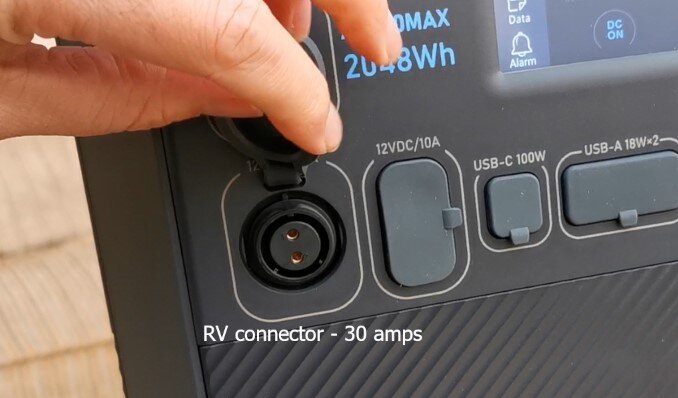 AC output – the right hand side of the touchscreen holds a very welcome sight. Four (yes four!) 3-pin UK AC mains plug sockets for 220-240V AC output. The top two sockets are flipped upside down with respect to the bottom two so that any cables don’t interfere. The AC power has to be enabled via the screen or the Bluetti smartphone app (see below).
AC output – the right hand side of the touchscreen holds a very welcome sight. Four (yes four!) 3-pin UK AC mains plug sockets for 220-240V AC output. The top two sockets are flipped upside down with respect to the bottom two so that any cables don’t interfere. The AC power has to be enabled via the screen or the Bluetti smartphone app (see below).- USB sockets – below the touchscreen are a range of 5 USB sockets
- 1 x 100W USB-C for high power operation of laptops etc.
- 2 x USB-A sockets with 18W output for fast charging.
- 2 x USB-A sockets with standard 5V/3A output (15W).
All of the above sockets have their own rubber cover which can help protect against dirt and water getting in to them. Although I’m glad these are included, I found them a little bit fiddly to keep pulling out in order to be able to use the required socket.
Top Panel
 The top surface of the Bluetti AC200 Max is dominated by the carry handles and a pair of wireless charging pads for smartphones. These can deliver 15W each and are a very nice feature for camping when you don’t always want to be fiddling with cables. You can position your phone on the pad (I found this had to be done fairly delicately) so that it starts charging. For this to work, the DC must be activated via the touchscreen or smartphone app.
The top surface of the Bluetti AC200 Max is dominated by the carry handles and a pair of wireless charging pads for smartphones. These can deliver 15W each and are a very nice feature for camping when you don’t always want to be fiddling with cables. You can position your phone on the pad (I found this had to be done fairly delicately) so that it starts charging. For this to work, the DC must be activated via the touchscreen or smartphone app.
Side Panel – Input Ports
The main input sockets for the AC200Max are on the left hand side of the power station, underneath a big fan outlet used for cooling. There are four input sockets for getting charge into the device.
- Battery expansion ports – there are 2 x battery expansion ports which can be used to connect up to two external Bluetti batteries, such as the B230 or B300. This is a way of massively expanding the capacity of your AC200Max at a lower price than if you bought additional power stations. The extra batteries become part of the main power station and can be fully controlled by the main unit or smartphone app.
- 900W solar input – the AC200Max has a solar input port which comes with its own connector for use with XT-90 or MC4 panels. The power station can take in up to 900W of solar power for charging, and can do this in conjunction with the 400W from the mains, giving 1.3kW of potential input power. At that level it will charge in around 2 hours – impressive, but needs lots of sun!
- Mains input socket – this port is where the output from the 400W mains power brick is connected, for a full charge in around 5.5-6 hours when used on its own. An additional mains power brick can be used for 800W of input power, but you need to buy an additional adaptor for this to work.
The Bluetti AC200Max In Use
So how does the AC200Max perform at home or in a campsite scenario. Well first off, carrying it around can be quite tiring due to the weight. I see no problem with bringing it in your car, motorhome or caravan if you’ve got the space but you are not going to want to frequently shift it when you get to your destination. I would certainly rule out taking it for a picnic, and would recommend something smaller like the Bluetti EB70 or Ecoflow River 2 if that’s your requirement.
Very Impressive 2.2kW Inverter
As mentioned previously, the inverter on the AC200max is rated at 2200W for stead state operation, and up to a whopping 4800W for peak power delivery in short bursts. This is extremely impressive, and we would rate the inverter as the best we’ve tested on any power station.
So what makes it so good? Well if you watch our review video, you’ll see why. It can power pretty much any household appliance that you throw at it. We tried the following with no problems:
- 3kW kettle in a 30-60 second burst – it successfully boiled some hot water in the kettle
- Steam iron
- Vacuum cleaners
- 4 element toaster for full duration to make toast
- 1.8kW fan heater
- leaf blower
- hedge cutter
- microwave
- cool box and fridge
This is extremely impressive performance. Even more impressive was when I connected up my guitar amplifier and was able to play with absolutely no hum being picked up from the power station. So the AC200max is the strong and silent type!
It’s worth mentioning fan noise of the Bluetti. The fans on the AC200Max do tend to come on when the power station is under a heavy load, however they are not excessively loud in the way that Ecoflow devices can be. It’s mildly disturbing, but not a dealbreaker in my opinion. Likewise, the mains power brick makes some noise, but again not excessive. I would place it mid-way between Ecoflow (noisy) and Jackery (quiet) in terms of fan noise.
 Smartphone App
Smartphone App
Bluetti have created a smartphone app which can connect to the AC200Max (or indeed any of their range) either via a mobile phone data connection, wifi or Bluetooth.
The app is a well-designed piece of software which essentially replicates all of the touchscreen functionality from the comfort of your phone. You don’t have to crawl on your hands and knees to see what you need to see.
I was impressed with the app because you can activate the DC and AC power independently and remotely. Most other power stations have buttons on the device which need to be pressed to do this. You can activate the AC200Max from your camping chair!
All settings can be configured from the app, and you can also check in-depth information on the status of the battery management system (BMS) as well as any expansion batteries attached to the unit.
Finally, you can also fully turn off the AC200Max using the app which is a great feature that I’ve not seen on other power stations. However, you can’t turn it back on again – you have to press the power button on the main front panel of the station to do that.
Charging Time
Mains-Only
For mains-only charging, the AC200Max charge time is fairly slow out of the box. This is because you’re limited by the 400W maximum input power from the supplied power brick, as well as the large 2048Wh of capacity. As a result, we measured the charge time as 5 hours 58 minutes taking the AC200Max from 0>100%. on mains.
If you wish to speed this up then you can half the time by purchasing a second power brick and adapter which increases the power to 800W and halves the time to around 3 hours. The adapter isn’t cheap though, and the slow charging is a bit of a downer when you can see that the competition (Jackery/Ecoflow) are about 3x faster.
Another small criticism is that the screen and app don’t give any indication of how much longer is required to reach full charge. They just show the current capacity level and %, but you have to estimate the remaining charge yourself from the 400W and % capacity remaining.
Mains + Solar Charging
With solar power engaged, the story becomes completely different and the Bluetti starts to shine. Using the standard power brick with solar power gives a combined input power of 1300W and a 0>100% charge time of around 2 hours under full, direct sunlight. Now you’re cooking on gas!
The downside of using solar in this way in the UK is that you are never guaranteed any bright sunlight, and certainly not for multiple hours in a row. It’s great that the AC200Max can combine solar and mains together for fast charging, but it’s unlikely to massively reduce your overall charge time, especially if you’re camping with just a 200W folding solar panel say.
Overall Verdict
The Bluetti AC200Max is definitely a capable power station – of that there is no doubt. It has the best inverter we’ve tested, even beating the Jackery 2000 Pro. The inverter can supply 2.2kW in steady state, and up to 4.8kW in surge mode – that is insane. On top of that, the inverter is low noise and did not make a squeak on our guitar amplifier.
The inputs, outputs and socket choices are all good too. I loved the inclusion of 4 x AC sockets as well as standard connector types for solar and DC (MC4 / XT-90 etc). Both DC and USB provision is good, and the inclusion of the wireless charging pads on the top can be really useful at the campsite.
We really like the touchscreen and the smartphone app with the great feature of being able to activate all sockets remotely, and even turn off the power station from afar – very nice indeed.
Unfortunately, there are a few downsides to the Bluetti which knocks some points off. LFP battery technology is great if you’re after the longest possible lifetime for your unit – for example if you’re discharging it every day from 100%>0% and then charging back up to 100%. If you’re camping then you probably won’t be using it in this way, and so you may not see the lifetime advantages which you’ve paid for.
The LFP batteries are also less energy dense than NMC, meaning that the AC200Max is the heaviest (28kg) and biggest (in terms of volume) power station we’ve tested. It’s also fairly inefficient at 73%, meaning you’re not getting all the storage capacity you might think you are. We measured a real capacity of 1500Wh against the nameplate capacity of 2048Wh. That being said, the battery capacity can be easily expanded and managed with the smartphone app – a very nice modular feature and Bluetti should be commended for this.
One final small downside is the mains charging capability. The 400W input power limitation and 6 hour charge time is not what I would expect from a flagship power station. I also don’t really like the external power brick which is cumbersome and even has its own fans which make additional noise. If you can live with the 6 hours by charging overnight say then it shouldn’t be a major issue, but it is not ideal in my view.
We've enjoyed testing the Bluetti AC200Max and would recommend it for people who are highly concerned about the safety and lifetime of Li-NMC batteries, and so want to use LFP instead. The inverter is excellent and this baby will power everything you can throw at it. Plenty of sockets and wireless charging round out the offering. It loses some points on charge time, weight and efficiency, but wins back more for its virtues. Definitely above average, but not perfect.


